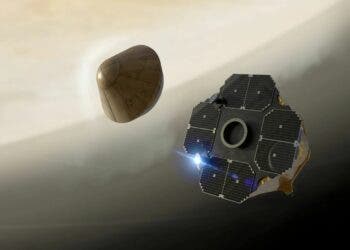
In May of this year, a small CubeSat satellite of about 25 pounds and the size of two stacked cereal boxes carrying the TeraByte InfraRed Delivery (TBIRD) payload was launched into orbit 300 miles above the Earth’s surface. Since then, the coolly-monikered TBIRD has transmitted terabytes of data to a ground-based receiver in California at the insane rate of up to 100 gigabits per second. Now, NASA has confirmed that TBIRD downlinked 1.4 terabytes over laser communications on a Dec. 1 pass that lasted around five minutes. NASA hopes to eventually demonstrate a downlink of 200 gigabits per second.
The current 100 Gbps data rate is more than 1,000 times greater than the radio-frequency links typically used for satellite communication and the highest ever attained by a laser link from space to ground. These world-record speeds were made possible by a communications payload about the size of a tissue box.
MIT Lincoln Laboratory envisioned the TBIRD mission in 2014 as a way to give science missions unheard-of capability at a relatively reasonable price. Science instruments in space generate more data than can be transmitted by standard communications channels from space to the ground. TBIRD can help scientists from across the globe fully utilize laser communications to downlink all the data they could ever want with the help of compact, affordable space and ground terminals.
Beam me up (and down), Scotty
The TBIRD communications payload was created and constructed at Lincoln Laboratory and attached to a Terran Orbital CubeSat as part of NASA’s Pathfinder Technology Demonstrator initiative. NASA Ames Research Center started this program to create a CubeSat bus, or “vehicle,” that would make it easier and less expensive to launch science and technology demonstration satellites into orbit.
Since most of the weather in Table Mountain, California, occurs below the mountain’s summit, this region of the sky is generally clear for laser communication. With the help of the NASA Jet Propulsion Laboratory’s Optical Communications Telescope Laboratory’s one-meter telescope and adaptive optics to correct distortions caused by atmospheric turbulence, this ground station uses TBIRD-specific ground communication hardware from Lincoln Laboratory.
“We’ve demonstrated a higher data rate than ever before in a smaller package than ever before,” says Jade Wang, the laboratory’s program manager for the TBIRD payload and ground communications and assistant leader of the Optical and Quantum Communications Technology Group. “While sending data from space using lasers may sound futuristic, the same technical concept is behind the fiber-optic internet we use every day. The difference is that the laser transmissions are taking place in the open atmosphere, rather than in contained fibers.”
If you’ve ever participated in a video conference, played an online game or watched a movie in high def, you’re using high-data-rate links that travel along glass or plastic optical fibers. These fibers, which are about the same diameter as human hair, are bundled together to form cables that use fast-moving pulses of light from a laser or other source to transmit data. In today’s Internet age, where massive amounts of data must be rapidly and reliably distributed across the globe, fiber-optic communications are crucial.
On the other hand, satellites do not yet have access to broadband internet enabled by laser communications. All the way back to the very first manned space flights in the 1950s, radio frequencies have been used to transmit information to and from space. Infrared light, used in laser communications, has a much higher frequency (or shorter wavelength) than radio waves, allowing for greater data compression. Similar to the transition from dial-up to high-speed internet here on Earth, laser communications will allow scientists to send 100 to 1,000 times more data than current radio-frequency systems.
The acceleration will benefit many science missions, from Earth observation to space exploration, as instrument capabilities improve to capture more high-resolution data, experiments become remote-controlled, and spacecraft travel farther into deep space.
“With the expanding interest and development in space-based laser communications, Lincoln Laboratory continues to push the envelope of what is possible,” Wang said. “TBIRD heralds a new approach with the potential to further increase data rate capabilities; shrink size, weight, and power; and reduce lasercom mission costs.”






